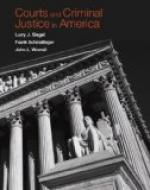CHAPTER III
Sensationalism and Jury Trials
For the past twenty-five years we have heard the cry upon all sides that the jury system is a failure, and to this general indictment is frequently added the specification that the trials in our higher courts of criminal justice are the scenes of grotesque buffoonery and merriment, where cynical juries recklessly disregard their oaths and where morbid crowds flock to satisfy the cravings of their imaginations for details of blood and sexuality.
It is unnecessary to question the honesty of those who thus picture the administration of criminal justice in America. Indeed, thus it probably appears to them. But before such an arraignment of present conditions in a highly civilized and progressive nation is accepted as final, it is well to examine into its inherent probabilities and test it by what we know of the actual facts.
In the first place, it should be remembered that the jury was instituted and designed to protect the English freeman from tyranny upon the part of the crown. Judges were, and sometimes still are, the creatures of a ruler or unduly subject to his influence. And that ruler neither was, nor is, always the head of the nation; but just as in the days of the Normans he might have been a powerful earl whose influence could make or unmake a judge, so to-day he may be none the less a ruler if he exists in the person of a political boss who has created the judge before whom his political enemy is to be tried. The writer has seen more than one judge openly striving to influence a jury to convict or to acquit a prisoner at the dictation of such a boss, who, not content to issue his commands from behind the arras, came to the courtroom and ascended the bench to see that they were obeyed. Usually the jury indignantly resented such interference and administered a well-merited rebuke by acting directly contrary to the clearly indicated wishes of the judge.




